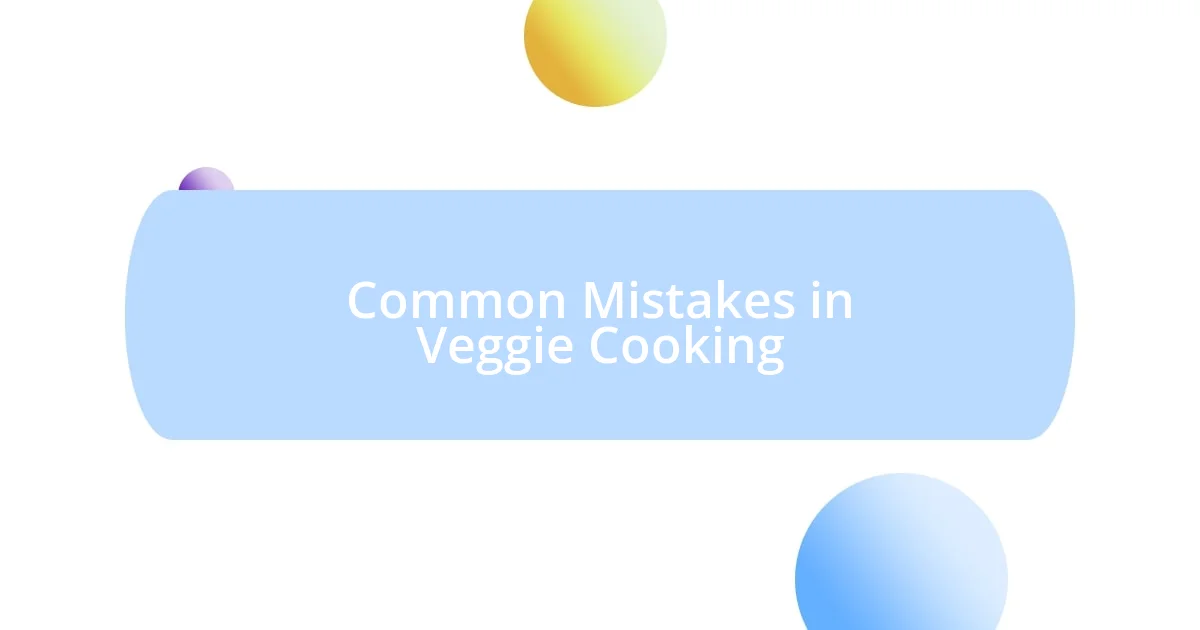Key takeaways:
- Master essential cooking techniques like roasting, sautéing, and blanching to enhance vegetable flavors and textures.
- Select seasonal and vibrant vegetables, focusing on their freshness and nutrient content for better cooking results.
- Experiment with herbs, spices, and acids to elevate the flavor of dishes, turning simple veggie preparations into memorable meals.

Understanding Veggie Cooking Essentials
When I first started cooking vegetables, I found it surprising how certain techniques could completely transform their flavors. For instance, roasting brings out a sweetness in carrots that you just don’t get with steaming. Have you ever noticed how a sprinkle of salt can ignite the natural taste in tomatoes? It’s simple moments like these that remind me of how essential proper seasoning is in veggie cooking.
Understanding cooking methods is critical. For example, sautéing is a quick way to lock in nutrients while still allowing for some delightful caramelization. I remember a time when I tried to hurry a stir-fry without preheating the pan, and the veggies ended up soggy instead of crisp. It taught me that patience and attention to heat will yield a much more satisfying dish.
Don’t overlook the importance of knife skills! When I began chopping vegetables, I was clumsy, often ending up with uneven pieces. But I soon learned that uniform cuts not only enhance presentation but also ensure even cooking. Have you ever tried a stir-fry with mismatched veggie sizes? It’s a real challenge to get them all cooked just right – another reminder that the basics of prep can make or break a dish.

Choosing the Right Vegetables
Choosing the right vegetables can make all the difference in your cooking experience. I fondly remember shopping at the farmer’s market for the first time; the vibrant colors and fresh scents were almost overwhelming. I quickly learned to prioritize seasonal vegetables, not just for flavor, but for freshness and cost-effectiveness. When you choose what’s in season, you’re rewarded with the best of what nature has to offer.
Here are some tips for selecting the best veggies:
- Go for vibrant colors: A rainbow on your plate often indicates a variety of nutrients.
- Check for firmness: Fresh vegetables should feel firm and not have any soft spots.
- Smell them: A fresh, earthy aroma is a good sign that the vegetables are ripe and full of flavor.
- Choose local when possible: Local veggies tend to be fresher and more flavorful, plus you support local farmers.
- Don’t shy away from imperfections: A few blemishes can indicate the vegetable is fresh and hasn’t been treated with chemicals, so embrace those quirky-looking specimens!
By focusing on these factors, you can create delicious veggie dishes that highlight the best flavors at your fingertips.

Essential Cooking Techniques for Vegetables
When it comes to cooking vegetables, mastering techniques like blanching and grilling can elevate your dishes. I still remember the first time I blanched green beans; the bright green hue instantly revived the visual appeal and retained their crispness. It’s a little trick that not only boosts color but also preps veggies for sautéing or freezing, turning a simple side into something special.
Another essential technique is steaming, which retains nutrients and allows for a bit of customization with flavorings. I used to steam broccoli plain, but then I discovered the joy of adding garlic and lemon zest. The difference was astonishing! It’s fascinating how a few simple ingredients can transform the essence of a vegetable, making it a dish rather than just a side.
Finally, let’s not forget the art of seasoning. I once made the mistake of underseasoning my roasted vegetables, and they tasted bland. Now, I’m generous with herbs and spices, treating them like an extension of the dish itself. A sprinkle of herbs can elevate even the most humble veggie, turning it into a star on your plate.
| Cooking Technique | Description |
|---|---|
| Blanching | Briefly boiling vegetables and then plunging them into cold water to retain color and crispness. |
| Steaming | Cooking vegetables over boiling water, preserving nutrients and texture. Can be enhanced with flavors. |
| Roasting | Cooking in an oven to enhance sweetness and caramelization; requires proper seasoning. |
| Sautéing | Quick frying in a bit of oil to retain nutrients while developing flavor. |
| Grilling | Cooking vegetables over an open flame or grill to achieve a smoky flavor and charred texture. |

Flavoring Your Veggie Dishes
When it comes to flavoring veggie dishes, I can’t stress enough the importance of herbs and spices. I recall a time when I hastily threw together a vegetable stir-fry, barely giving a thought to seasoning. The result was underwhelming, and it hit me: flavor is everything! Now, I make it a point to experiment with fresh herbs—basil, cilantro, parsley—and even dried spices like cumin and paprika. Each choice adds depth and complexity, turning an ordinary meal into something truly memorable.
Marinating vegetables is another game-changer. I once marinated portobello mushrooms in a mixture of balsamic vinegar and olive oil, letting them soak up the flavors for an hour. The transformation blew me away! Not only did the marinade seep into the mushrooms, but it also created a beautifully caramelized exterior when grilled. Imagine biting into that—delicious! What I’ve learned is that letting vegetables marinate not only enhances their taste but also gives them a lovely texture.
Don’t overlook the power of acids, either! A drizzle of lemon juice or a splash of apple cider vinegar can brighten up any dish, and I often found myself neglecting this simple addition. I remember a beet salad that seemed pretty dull until I squeezed fresh lemon juice over it. Suddenly, all the flavors popped, and what was once a simple combination of ingredients sang in harmony. Have you tried adding a splash of acidity to your favorite veggie dish? It might just elevate your cooking to a new level!

Healthy Cooking Methods for Vegetables
Healthy cooking methods for vegetables can significantly influence not only the flavor but also the nutritional benefits of your dishes. For instance, I remember the first time I opted for sautéing instead of boiling. Just a splash of olive oil and a couple of garlic cloves transformed zucchini from a bland side into a vibrant dish bursting with flavor. It’s amazing how this quick cooking method can preserve both texture and nutrients while allowing for creative additions.
Grilling is another method that has become a favorite of mine. The smoky flavor that develops while cooking veggies over open flames is simply irresistible. I still can’t forget the joy of biting into a charred corn on the cob topped with a sprinkle of lime and chili powder — pure summer bliss! Have you ever experimented with grilling vegetables? If not, I strongly encourage you to fire up that grill and see how it elevates your cooking.
Lastly, I’ve found that roasting vegetables brings out their natural sweetness in a way that’s truly delightful. I vividly recall my first attempt at roasting carrots with a drizzle of honey and a dash of cinnamon; the sweet aroma wafting through the kitchen was tempting enough to get the family to gather around the dinner table. The caramelized edges added a beautiful depth of flavor that made the effort worthwhile. So, what’s stopping you from trying these healthy cooking methods and making your veggie dishes shine?

Common Mistakes in Veggie Cooking
One common mistake I’ve noticed in veggie cooking is not giving vegetables enough time to shine on their own. I remember a time when I hastily combined an array of colorful veggies without considering their individual cooking times. That resulted in mushy broccoli and al dente bell peppers, which was far from the delightful medley I envisioned. Have you ever faced the frustration of unevenly cooked vegetables? It’s worth taking a moment to understand which veggies need more time so each flavor can fully develop.
Another pitfall many face is overcrowding the pan. I’ve certainly been guilty of this! There was a night when I tossed every vegetable I had into one skillet, thinking I was doing something efficient. Instead of a gorgeous sauté, I ended up with steam and a sad, watery mix. It’s a simple fix: give your vegetables space to breathe. Not only will they caramelize beautifully, but they’ll also retain their vibrant colors.
Lastly, I often see folks neglecting the importance of texture. When I first attempted to make a salad, I used raw spinach, tomatoes, and cucumbers without a second thought. The result was bland and uninteresting. It hit me hard that adding a crunch—like roasted nuts or crispy chickpeas—can elevate a dish tenfold. Have you experimented with different textures in your veggie dishes? A range of textures not only makes your meal visually appealing but also provides a delightful eating experience.

Creative Recipes Using Vegetables
Exploring creative recipes using vegetables can be incredibly rewarding, and I’ve had my fair share of fun experimenting in the kitchen. One standout dish I crafted was a colorful ratatouille, where I took the classic French recipe and added my own twist—sautéing each vegetable separately to enhance their unique flavors. The result was a vibrant tapestry of eggplant, zucchini, and bell peppers, all beautifully mingled in a herbed tomato sauce. Have you ever thought about layering flavors in such a way? I found that the extra effort completely transformed the dish.
Another delightful surprise came when I decided to try my hand at vegetable sushi rolls. Using a mix of avocado, cucumber, and roasted sweet potatoes, I was amazed at how satisfying it felt to roll them up tightly in seaweed. Not only did they look stunning on the plate, but dipping them in a soy sauce and wasabi blend made for an exciting flavor explosion with every bite. It got me thinking—why limit sushi to fish? Sometimes, I wonder what other fun combinations we might be missing out on if we just let our creativity flow.
I also recall one evening, inspired by the flavors of Mediterranean cuisine, I whipped up a chickpea and vegetable stew that really warmed my heart. Chopped tomatoes, spinach, and a generous splash of lemon juice infused the dish with a refreshing zest that took me right back to my travels. As I savored each spoonful, I couldn’t help but smile; it felt nourishing not only for my body but for my soul. Have you ever had a meal that just resonated with you deeply? It’s moments like these that remind me how profoundly vegetables can elevate our cooking experience.














